 In early December 2016 I visited central Williamsburg in Brooklyn, New York, where my 2x great-grandparents Thomas and Anna Maria Christ and their son George and his family, including my father’s father Irving John, lived for over fifty years. I had compiled a list of all the known addresses of the family in Williamsburg from census and death records. The family lived in a several block square area surrounding Most Holy Trinity Roman Catholic Church on Montrose Street for all that time.
In early December 2016 I visited central Williamsburg in Brooklyn, New York, where my 2x great-grandparents Thomas and Anna Maria Christ and their son George and his family, including my father’s father Irving John, lived for over fifty years. I had compiled a list of all the known addresses of the family in Williamsburg from census and death records. The family lived in a several block square area surrounding Most Holy Trinity Roman Catholic Church on Montrose Street for all that time.
Most of the buildings at the addresses where the family lived had been torn down and replaced with housing projects in the mid-twentieth century. Some of the remaining ones are being torn down today, as this area of Williamsburg is being gentrified. Still, enough of the old buildings remain to give a sense of what the neighborhood was like in the 1800s.
Maria Christ lived at 170 Montrose Street, just a few doors down from the church in 1890, in the happy days when George was married and new grandchildren were coming every few years..
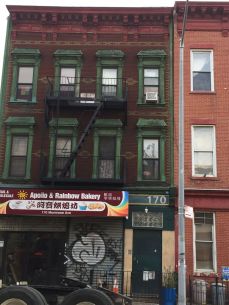
The houses across the street still stand. Maria and George were “working on vests,” as tailors, in 1881 at 177 Montrose.
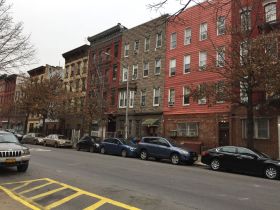
155 Messerole St. where Maria lived as single mother with twelve year-old George and worked as a “tailoress” in 1875 was torn down and rebuilt, though the adjoining houses remain.
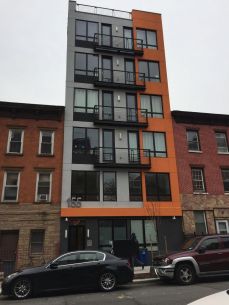
134 Scholes St. where Christian Scheffling lived with his first wife and family has become a well-maintained “vest pocket” park.
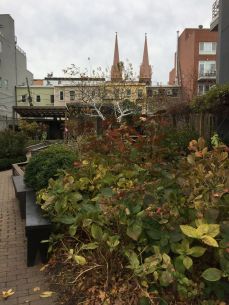
*
There have been three Most Holy Trinity Church buildings on the same parcel of land. The first was built in 1841 in a cornfield. The area was still rural when Thomas and Anna Maria arrived in 1849. Thomas and Anna Maria, who had been prevented from marrying in Bavaria, may have married in the first church. Their first son Conrad was baptized in this church in 1850.
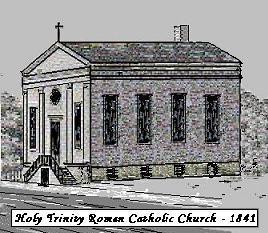
Their son George was baptized in 1863 in the second church, built in 1854. Thomas’s funeral in December 1863, less than a year after George’s birth, was held in this church. Conrad who died around the same time as his father would also have been buried from there.

In A Tree Grows in Brooklyn, Francie describes the third church as “the most beautiful church in Brooklyn. It was made of old gray stone and had twin spires that rose cleanly into the sky, high above the tallest tenements. Inside, the high vaulted ceilings, narrow deepset stained-glass windows and elaborately carved altars made it a miniature cathedral.”
George and Maria went to mass there after it was dedicated in 1885. George’s children were baptized in it in the 1880s and 1890s. The funerals of George who died at the age of thirty-two of tuberculosis in 1895 and of his young son Fred in 1896, and of Maria in 1907 were held there.
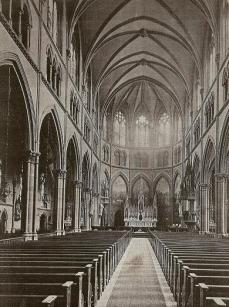
A kindly Franciscan Friar opened the church doors for us. I was pleased to learn that Franciscans have served the church from its beginnings, as I imagine them to be more loving and less legalistic than other priests.
German wood carvings, reminiscent of the “Old Country,” adorn the pulpit. German immigrants were employed to craft them and many of the building materials were imported from Germany.
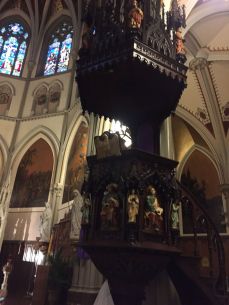
Maria Christ must have lit many candles as she poured out her heart to the Blessed Virgin and found refuge from poverty, hardship, and loss in the silence and beauty of the church. I lit a candle for Maria and for all of the family who had worshiped in the church or who had descended from those who did.
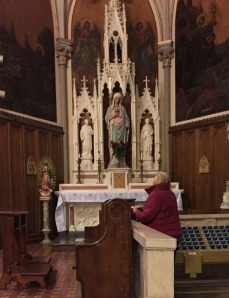
*
Most Holy Trinity Cemetery, which opened in 1851 to replace an earlier cemetery adjacent to the church, is within walking distance. According to the church website, “Many, if not most of those who are interred in the cemetery, had lived and raised their families in our neighborhood; they had worshiped in our church building and had called Trinity ‘home.’ We continue to honor the memory of those buried in our cemetery; we continue to pray for their souls. May the souls of all the faithful departed, through the mercy of God, rest in peace. Amen.”
Telephoning the Church archives office, I learned that Thomas Christ was buried in the cemetery in 1863, but that there was no record of where. Anna M. Christ was buried in Block 33, Row 7, grave 16 in 1907. Their son George who died in 1895 and his son Fred who died in 1896 were buried in Block 74, Row 2, grave 21. I asked about Thomas and Maria’s son Conrad who died between 1860 and 1865, but as I did not have his date of death, the office administrator could not locate the information. I was told that the graves have reverted to the Church because of “dereliction.”
With this information, I was able to deduce that the grave in Block 74 must have been purchased after the grave in Block 33. The first grave would have been for Conrad or Thomas. Anna Maria would have been buried with her husband and son. George was not buried with the rest of his family but in the new Block 74, probably because his wife Catherine anticipated being buried with him. Fred, who died just over a year after George, was buried with his father. By the time George and Catherine’s daughter Anna died in 1904, Catherine had married Christian Scheffling and left the neighborhood. Anna was probably given a Protestant burial, as Catherine was originally Lutheran and Christian Scheffling was Protestant. Dying more than thirty years after her first husband, Catherine would have been buried with her second. I have yet to locate these graves.
Most Holy Trinity Cemetery is known as the “Metal Cemetery.” Stone markers were prohibited so that there would be no great distinctions between the graves of the rich and the poor. The blocks are clearly marked. Many of the gravestones are numbered: 74, 2, 21 would be Block 74, row 2, grave 21. Our family’s graves have no gravestones, but I was able to find their exact locations based on the numbers on nearby graves.
I left two white carnations (left) on the graves of Fred and George.

And three white carnations on the graves of Thomas, Conrad, and Maria.
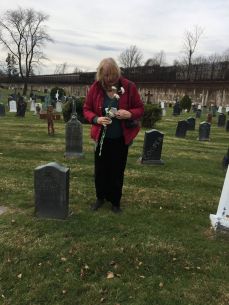
*
As I share the stories of visiting the places where my ancestors lived and were buried, I am often asked why I have embarked on this journey and what it means to me. I undertook the search for my ancestors out of curiosity and a desire to know my roots. Over the years, I have found more than I ever imagined I would. To date, I know the towns where twelve of my sixteen 2x great-grandparents were born. The only mysteries that remain are to be found in Ireland and Scotland.
On one level, I enjoy the detective work. There are worse ways to spend my time. I delight in every piece of information I glean–especially when I it has eluded me.
On a deeper level, ancestor connection has become part of my spirituality.
As I wrote in Goddess and God in the World, I was provoked by Karen Baker-Fletcher to consider the relationship between ancestor connection and connection to the land. I came to understand that the insight that “we are deeply connected in the web of life” means not only that we are connected to the earth and all beings with whom we share it, but also that we are connected to all of those who have gone before us, human and other than human, whose lives have made ours possible. The proper response to this knowledge is gratitude.
*
Not many people come to the Metal Cemetery these days. When I visited it with my friend Joyce, a single woman out for a walk was the only other living human presence. Most of the descendants of those who once made their home in the circle created by Most Holy Trinity German Roman Catholic Church have long since moved on. Few of us know where our ancestors were buried or where or how they lived.
These days, I am wondering if loss of the knowledge of our roots is one of the reasons so many Americans cling so tightly to abstract concepts of “whiteness” and “America.” Communing with so many ancestors whose lives were so much more than white and American—though many were that too—I am at one and the same time more firmly rooted and able to walk more lightly in the world. I can affirm all that I am, while clinging to nothing, for I know that everything will change, as it has changed in the past not just for me, but for all of those whose lives are re-membered in me.
*Thanks to Joyce Zonana for guiding me in Williamsburg and for taking the photographs.
* * *
 Carol P. Christ’s new book written with Judith Plaskow is Goddess and God in the World: Conversations in Embodied Theology. They are co-editors of Womanspirit Rising and Weaving the Visions. Carol wrote the first Goddess feminist theology, Rebirth of the Goddess and the process feminist theology, She Who Changes.
Carol P. Christ’s new book written with Judith Plaskow is Goddess and God in the World: Conversations in Embodied Theology. They are co-editors of Womanspirit Rising and Weaving the Visions. Carol wrote the first Goddess feminist theology, Rebirth of the Goddess and the process feminist theology, She Who Changes.
Listen to Judith and Carol’s first interview on the book on Northern Spirit Radio and their second on WATER.
Carol P. Christ leads the Goddess Pilgrimage to Crete. Join the 2017 spring and fall tours now and save $150.


What a journey, Carol! I recognized the names of the streets right away from constant reading of “A Tree Grows in Brooklyn” when I was a child. It’s an ambitious project to discover the names and graves of your ancestors, but how worthwhile. Thank you for this.
LikeLike
My grandfather was born just over a year before “Betty Smith” in the same neighborhood and he lost his father when he was a baby. I just reread the book.The “meals” of stale bread and condensed milk stick in my mind.
LikeLike
My mother always told me that stale bread was better for me…fresh bread would knot in my tummy and make me sick! Last week I saw a display of condensed milk on sale at the grocery store. Didn’t know they still make it!
Love reading your genealogy adventure Carol. Thank you for sharing it.
LikeLike
Thanks Carol, I live in New York City, as you know, but these pictures of churches have me flashing back to a time when I used to do morning meditation every day at a convent in New York City with a Franciscan nun and a group of Sisters of Charity.
The Franciscan nun and I were arrested together for protesting nuclear weapons and we were put in a paddy wagon, and taken to jail. It’s amazing that people quietly protesting war, are jailed. The nun’s case when we got to court was dismissed, but I was not a nun, so when my case was called, right after hers, and I had to face the judge, the nun told her lawyer to speak up for me and thereby my case was dismissed also. I loved and respected that Franciscan nun so much. Her name was Sr. Anne Montgomery, and sadly she died in 2012, but at least she did live into her 80’s.
I linked my name here to a webpage with a picture of Sr. Anne Montgomery and including some of her amazing background. I bow to her and all that she gave to this world.
LikeLike
I have had a similar thought about the USA and our lack of connection to the past and our roots. We are left rootless, adrift in a sea of consumerism here, whereas those from countries with long histories can connect themselves through the land to their genetic ancestors. Of course the Native Americans have that deep connection to the land and the ancestors, yet it has been tainted for them by the genocide and conquest. Looking forward to hearing what you find about your Irish and Scottish roots.
LikeLike
Very inspiring story-all your experiences so close to my own at Calvary Cemetary in Long Island City,new York
.
LikeLike
I have relatives there too. What was your experience?
LikeLike